|
Strain Name
|
C57BL/6-Ifngr1tm1(IFNGR1)BcgenIfngtm1(IFNG)BcgenIfngr2tm1(IFNGR2)Bcgen/Bcgen
|
Common Name
|
B-hIFNGR1/hIFNG/hIFNGR2 mice
|
|
Background
|
C57BL/6
|
Catalog number
|
130949
|
Related Genes
|
IFNG: IFG, IFI, IMD69,IFN-γ IFNGR1: CD119, IFNGR, IMD27A, IMD27B;
IFNGR2 also named AF-1;
IFGR2; IMD28; IFNGT1
|
mRNA expression analysis
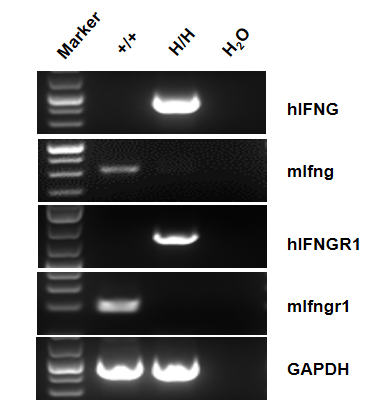
IFNG and IFNGR1 expression analysis in B-hIFNGR1/hIFNG mice by RT-PCR. Human IFNG and IFNGR1 mRNA were detectable in splenocytes of the homozygous B-hIFNGR1/hIFNG mice (H/H) but not in wild-type mice (+/+).
Protein expression analysis
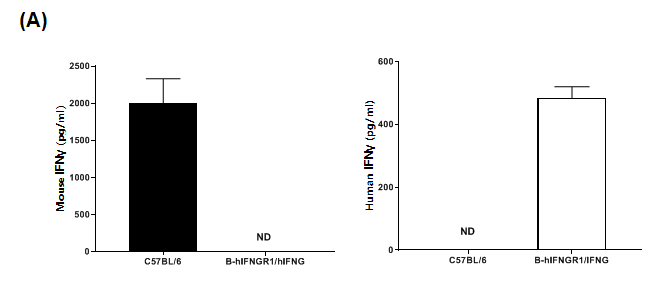
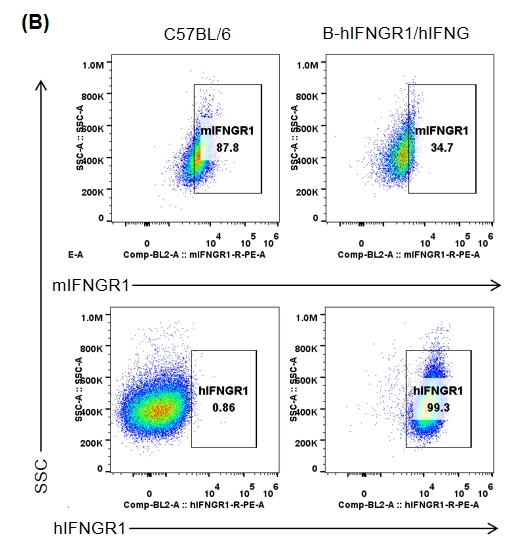
IFNG and IFNGR1 expression analysis in B-hIFNGR1/IFNG mice. (A) IFNG expression. Serum was collected from wild-type C57BL/6 mice and homozygous B-hIFNGR1/hIFNG mice (anti-CD3ε antibody, 2 hours, in vivo) and analyzed by ELISA with species-specific IFNG ELISA kit. Human IFNG was exclusively detectable in homozygous B-hIFNGR1/hIFNG mice but not in wild-type mice. (B) IFNGR1 expression. Peritoneal derived macrophage cells were collected, and analyzed by flow cytometry with anti-IFNGR1 antibody. Human IFNGR1 was detectable in B-hIFNGR1/hIFNG mice.
mRNA and protein expression analysis

Strain specific analysis of IFNGR2 gene expression in wild-type mice and B-hIFNGR2 mice by RT-PCR and western blotting. (A) mRNA expression. Mouse Ifngr2 mRNA was exclusively detectable in the small intestine of wild-type mice (+/+). Human IFNGR2 mRNA was exclusively detectable in homozygous B-hIFNGR2 mice (H/H). (B) Protein expression. Skeletal muscle was collected from wild-type C57BL/6 mice (+/+) and homozygous B-hIFNGR2 mice (H/H), and analyzed by western blotting with anti-IFNGR2 antibody which can recognize both human and mouse IFNGR2. The results show that IFNGR2 protein can be detected in homozygous B-hIFNGR2 mice.
IFNGR1 expression in different immune cells
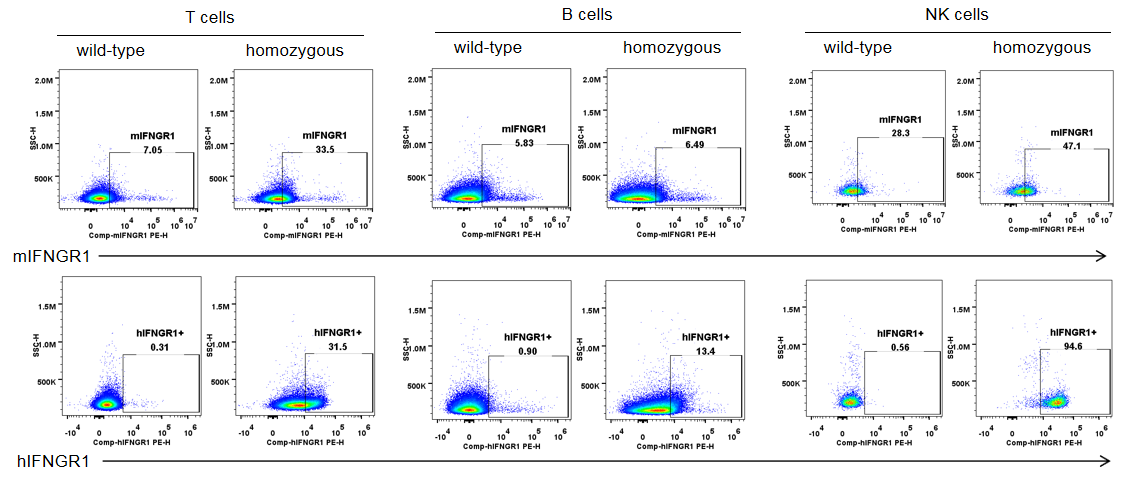
IFNGR1 expression analysis in B-hIFNGR1/IFNG/hIFNGR2 mice. Splenocytes were collected from wild-type C57BL/6 mice and homozygous B-hIFNGR1/hIFNG/hIFNGR2 mice, and analyzed by flow cytometry with anti-IFNGR1 antibody. Human IFNGR1 was detectable in T cells, B cells and NK cells of B-hIFNGR1/hIFNG/hIFNGR2 mice.
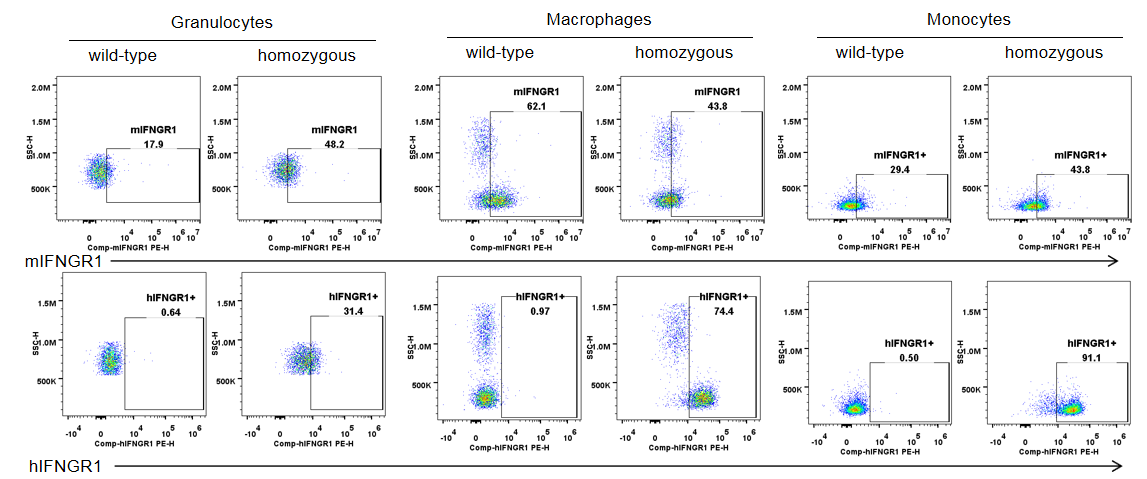
IFNGR1 expression analysis in B-hIFNGR1/hIFNG/hIFNGR2 mice. Splenocytes were collected from wild-type C57BL/6 mice and homozygous B-hIFNGR1/IFNG/hIFNGR2 mice, and analyzed by flow cytometry with anti-IFNGR1 antibody. Human IFNGR1 was detectable in granulocytes, macrophages and monocytes of B-hIFNGR1/hIFNG/hIFNGR2 mice.
IFNγ induced phosphorylation of STAT1 in T, B and NK cells
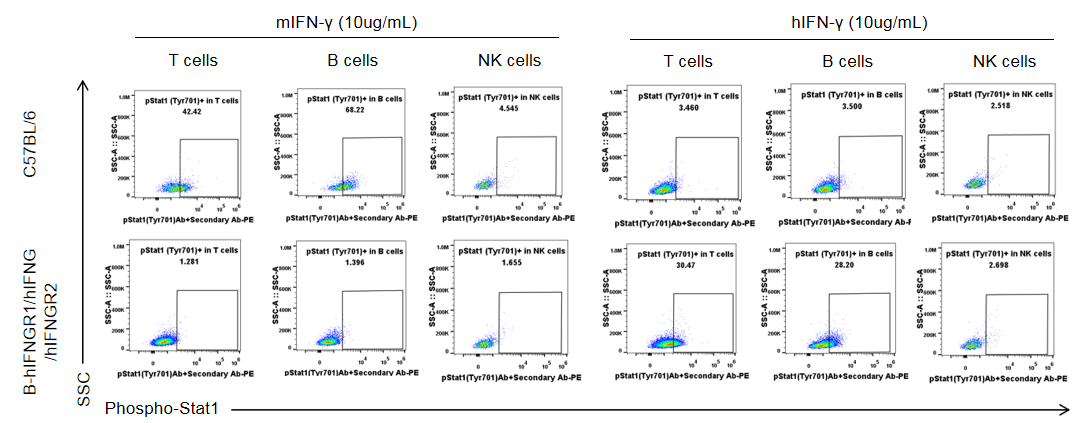
Analysis of the IFNγ induced pSTAT1(Tyr701) in wild-type C57BL/6 mice and homozygous B-hIFNGR1/hIFNG/hIFNGR2 mice by flow cytometry. Splenocytes from wild-type mice and homozygous mice (female, 7-week-old) were treated with IFNγ for ex vivo, and then flow cytometry was performed to analyze the phosphorylation of STAT1. Mouse IFN-γ induced the expression of pSTAT1 in T and B cells of wild-type mice but not humanized mice. Human IFN-γ induced the expression of pSTAT1 in T and B cells of humanized mice but not wild-type mice. Among NK cells, IFN-γ not induced the STAT1 phosphorylation in both mice.
IFNγ induced phosphorylation of STAT1 in T, B and NK cells

Analysis of the IFNγ induced pSTAT1(Tyr701) in wild-type C57BL/6 mice and homozygous B-hIFNGR1/hIFNG/hIFNGR2 mice by flow cytometry. Splenocytes from wild-type mice and homozygous mice (female, 7-week-old) were treated with IFNγ in doses shown in the panel for ex vivo, and then flow cytometry was performed to analyze the phosphorylation of STAT1. Mouse IFNγ induced the expression of pSTAT1 in T and B cells of wild-type mice but not humanized mice. Human IFNγ induced the expression of pSTAT1 in T and B cells of humanized mice but not wild-type mice. Among NK cells, IFNγ not induced the STAT1 phosphorylation in both mice.
hIFNγ upregulates mPD-L1 in splenocytes from triple-KI mice, not WT mice

hIFNγ upregulated mPD-L1 in splenocytes from homozygous B-hIFNGR1/hIFNG/hIFNGR2 mice (Triple-KI). Splenocytes at 0.5x106/well (96-well plate) were treated with 100ng/mL hIFNγ for 24 hours at 37℃. Cells were collected and assessed for mPD-L1 expression by flow cytometry. As shown, hIFNγ induced the expression of mPD-L1 in triple-KI mice but not in wild-type mice.
*The experiment is verified by the cooperation partner.
Activated splenocytes from triple-KI mice produce human IFNγ
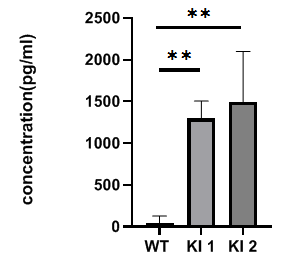
Analysis of hIFNγ production in activated splenocytes from homozygous B-hIFNGR1/hIFNG/hIFNGR2 mice (Triple-KI). Cells were seeded in a 96-wells plate for 0.5X106 cells/well. The plate was precoated with 8μg/mL anti-mCD3 mAb at 4 ℃ for overnight. Then incubated the cells at 37℃ 5% CO2 for 5 days. Anti-CD28 at 1μg/mL and 100U hIL2 were added 16 hours after culture. Get the supernatant for ELISA analysis. hIFNγ was detection in triple-KI mice but not in wild-type mice.
*The experiment is verified by the cooperation partner.


















